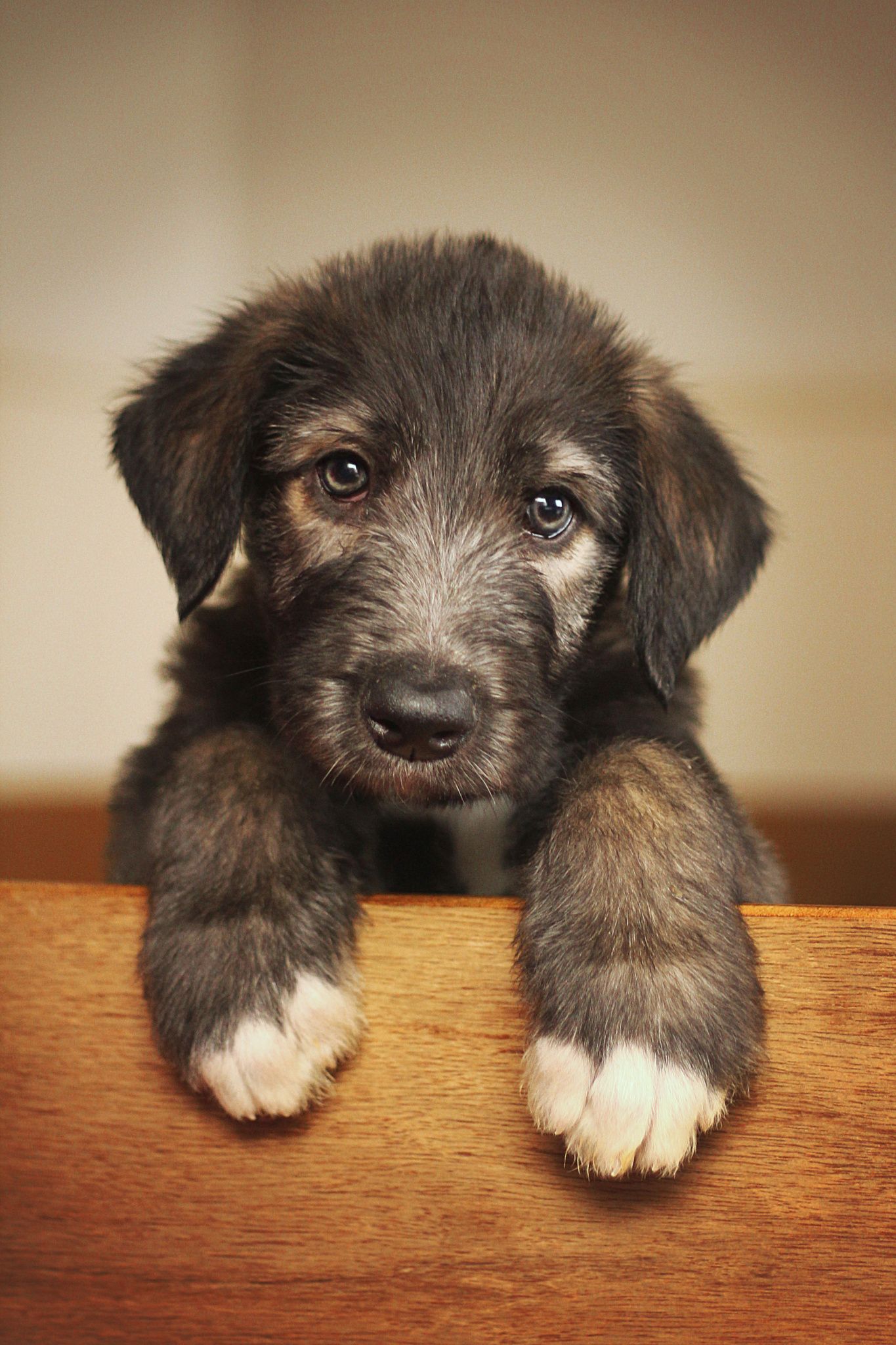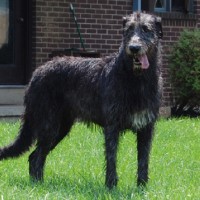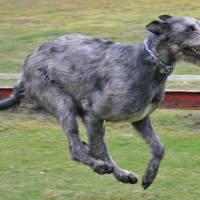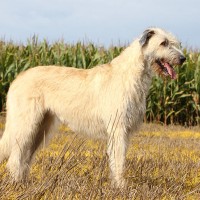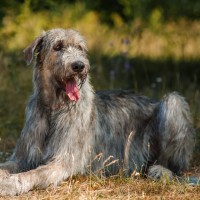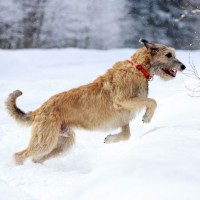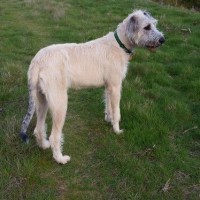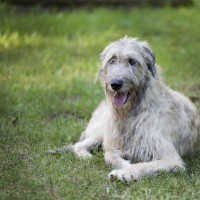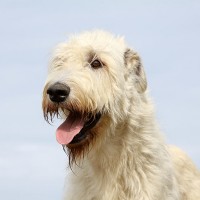Breed information
Group:
Hound
Life span: 6-10 years
Height male: 71-90 cm/ 28-35 inches
Height female: 71-90 cm/ 28-35 inches
Weight male: 40-69 kg/ 90-150 pounds
Weight female: 40-69 kg/ 90-150 pounds
Character: Dignified, Generous, Loyal, Patient, Sweet-Tempered, Thoughtful, Intelligent
History
The breed is very old; there are suggestions it may have been brought to Ireland as early as 7000 BC. These dogs are mentioned, as cú (variously translated as hound, Irish hound, war dog, wolf dog, etc.) in Irish laws and in Irish literature which dates from the 5th century or, in the case of the Sagas, from the old Irish period - AD 600-900. The word "Cú" often became an added prefix of respect on the names of warriors as well as kings denoting that they were worthy of the respect and loyalty of a Cú.
Pre-19th century
Ancient artworks and writings have encouraged modern authors to imagine their existence as a breed by 273 BC. However, there is indication that large dogs may have existed even as early as 279 BC when the Tectosages and Tolistobogii Celts sacked Delphi. Survivors left accounts of the fierce Celts and the huge dogs who fought with them and at their side. They were mentioned by Julius Caesar in his treatise, The Gallic Wars, and by 391 AD, they were written about by Roman Consul, Quintus Aurelius Symmachus, who received seven of them, "canes Scotici", as a gift to be used for fighting lions and bears, in his words, "all Rome viewed (them) with wonder".
Wolfhounds were bred as hunting dogs by the ancients, who called them Cú Faoil. The Irish continued to breed them for this purpose, as well as to guard their homes and protect their stock. Cúchulain, a name which translates literally as "hound of Culain", gained his name when as a child, known then as Sétanta, when he slew the ferocious guard dog of Culain, forcing him to offer himself as a replacement. During the English Conquest of Ireland, only the nobility were allowed to own Irish Wolfhounds, the numbers permitted depending on position. They were much coveted and were frequently given as gifts to important personages and foreign nobles. Wolfhounds were the companions of the regal, and were housed themselves alongside them. King John of England, in about 1210 presented an Irish hound, Gelert, to Llewellyn, a prince of Wales. The poet The Hon William Robert Spencer Immortalized this hound in a poem.
In his History of Ireland completed 1571, Edmund Champion gives a description of the hounds used for hunting the wolves on the Dublin and Wicklow mountains. He says: They (the Irish) are not without wolves and greyhounds to hunt them, bigger of bone and limb than a colt. Due to their popularity overseas many were exported to European royal houses leaving numbers in Ireland depleted. This led to a declaration by Oliver Cromwell himself being published in Kilkenny on 27 April 1652 to ensure that sufficient numbers remained to control the wolf population.
References to the Irish Wolfhound in the 18th century tell of its great size, strength and greyhound shape as well as its scarcity. Writing in 1790, Bewick described it as the largest and most beautiful of the dog kind; about 36 inches high, generally of a white or cinnamon colour, somewhat like the Greyhound but more robust. He said that their aspect was mild, disposition peaceful, and strength so great that in combat the Mastiff or Bulldog was far from being an equal to them. The last wolf in Ireland is thought to have been killed at Myshall, on the slopes of Mount Leinster in Co. Carlow in 1786 by a pack of wolfdogs kept by a Mr Watson of Ballydarton. The remaining hounds in the hands of a few families who were mainly descendants of the old Irish chieftains, were now symbols of status rather than hunters, they were said to be the last of their race.
Modern wolfhoun
Scotsman Captain George Augustus Graham is responsible with a few other breeders for attempting to reaffirm the breed's existence. In 1879 he wrote: "It has been ascertained beyond all question that there are few specimens of the breed still left in Ireland and England to be considered Irish Wolfhounds, though falling short of the requisite dimensions. This blood is now in my possession." Captain Graham devoted his life to ensuring the survival of the Irish Wolfhound. Owing to the small numbers of surviving specimens outcrossing was used in the breeding programme. It is believed that Borzoi, Great Dane, Scottish Deerhound and English Mastiff dogs all played their part in Graham's creation of the dog we currently know. The famous English Mastiff Garnier's Lion was bred to the Deerhound Lufra, and their offspring Marquis enters Wolfhound pedigrees through his granddaughter Young Donagh. Graham included "a single outcross of Tibetan Wolf Dog". This was long assumed to have been a Tibetan Mastiff. However, a photograph of "Wolf" shows a bearded, long-coated dog—what would now be called a "Tibetan Kyi Apso" or "dokhyi apso". In 1885 Captain Graham with other breeders founded the Irish Wolfhound Club, and the Breed Standard of Points to establish and agree the ideal to which breeders should aspire.
The Wolfhound was historically a dog that only nobles could own and was taken up by the British during their rule in Ireland. This made it unpopular as a national symbol and the Kerry Blue Terrier was adopted by Republicans such as Michael Collins.The Wolfhound has been adopted as a symbol by both rugby codes. The national rugby league team is nicknamed the Wolfhounds, and the Irish Rugby Football Union, which governs rugby union, changed the name of the country's A (second-level) national team in that code to the Ireland Wolfhounds in 2010.
Description
Of great size and commanding appearance, the Irish Wolfhound is remarkable in combining power and swiftness with keen sight. The largest and tallest of the galloping hounds, in general type he is a rough-coated, Greyhound-like breed; very muscular, strong though gracefully built; movements easy and active; head and neck carried high, the tail carried with an upward sweep with a slight curve towards the extremity. The minimum height and weight of dogs should be 32 inches and 120 pounds; of bitches, 30 inches and 105 pounds; these to apply only to hounds over 18 months of age. Anything below this should be debarred from competition. Great size, including height at shoulder and proportionate length of body, is the desideratum to be aimed at, and it is desired to firmly establish a race that shall average from 32 to 34 inches in dogs, showing the requisite power, activity, courage and symmetry.
Health
Like many large dog breeds, Irish Wolfhounds have a relatively short lifespan. Published lifespan estimations vary between 6 and 10 years with 7 years being the average. Dilated cardiomyopathy and bone cancer are the leading cause of death and like all deep-chested dogs, gastric torsion (bloat) is common; the breed is affected by hereditary intrahepatic portosystemic shunt.
In a privately funded study conducted under the auspices of the Irish Wolfhound Club of America and based on an owner survey, Irish Wolfhounds in the United States from 1966 to 1986 lived to a mean age of 6.47 and died most frequently of bone cancer. A more recent study by the UK Kennel Club puts the average age of death at 7 years. Studies have shown that neutering is associated with a higher risk of bone cancer in various breeds, with one study suggesting that castration of male Irish Wolfhounds should be avoided at least until the dog is fully grown.
Irish Wolfhounds should not receive additional supplements when a good dog food is used. It is generally accepted that they should be fed a low protein adult dog food (19 to 21% protein) from puppyhood onward. Most breeders today recommend that they not be supplemented to slow their rapid growth. Irish Wolfhounds are the tallest of all dog breeds, sometimes reaching 7 feet tall on their hind legs. They are well suited to rural life, but their medium energy profile allows them to adjust fairly well to suburban and urban life as well, provided they receive appropriate exercise. Genetically, the Irish Wolfhound as a breed is threatened by a bottleneck related to the over-use of a popular sire.
Personality
According to AKC Standards, “Of great size and commanding appearance, the Irish Wolfhound is remarkable in combining power and swiftness with sight." Irish Wolfhounds are massive dogs that can be an imposing force, but are true gentle giants. Reliable and loyal family companions, this breed bonds deeply with his people and wants to be included in all aspects of family life. Their sheer size is enough to scare away those with ill intentions, but Irish Wolfhounds are by no means guard dogs. They are polite to strangers and many expect that all people are willing to (and should) provide belly rubs on command. They are too large to safely play with small children, but Wolfhounds are very patient with kids who want to climb all over them and and enjoy romping with older kids.
Activity Requirements
Though large and athletic looking, Wolfhounds tend to be couch potatoes and need to be coaxed to get out and exercise. Several daily walks and the occasional weekly opportunity to stretch their legs and run is enough exercise to keep a Wolfhound happy. Finding the right balance of exercise to keep him from becoming destructive can be tricky, and often people get lulled into laziness because their dog isn't itching to get outside. On the flip side, some Wolfhounds are rambunctious and hyperactive and that can be hard to quell, even with proper exercise. These dogs are far to big and clumsy to live in an apartment. Without enough space to move about, the Wolfhound will knock over tables, lamps and drinks.
Trainability
Irish Wolfhounds are difficult to train. They have a mind of their own and like to do things on their own terms. Inexperienced dog owners will often back down from training exercises when their Wolfhound exhibits stubbornness or boredom because this giant dog can be intimidating, but consistency in training and setting boundaries is necessary. They are puppies until they are about two years old, and if they aren't properly trained by the time adolescence sets in, it can be difficult to reign them in.
Best Training Equipment Trainers Recommend
Behavioral Traits
Animal aggression is common among Wolfhounds. They were originally bred as combat dogs, and watched over sleeping armies at night. Eventually they were used to hunt wolves, and their hunting instincts are still present today. Even though this breed is pleasant with people and gets along with other family pets or dogs he meets at the park, Wolfhounds can become aggressive toward dogs he does not know who trespass on his property.
Shedding
Irish Wolfhounds shed year round, but weekly brushing is enough to keep loose hair under control and keep coat healthy. Wolfhounds are clean dogs, who only need bathed a few times per year, unless of course, they have gotten particularly dirty outdoors. The mane and body hair can be stripped by hand or with a stripping knife, but should not be thinned too much. The hair on the face and neck are what give him his distinctive look. Check the ears on a regular basis for signs of wax buildup, irritation or infection. Clean the ears with a cotton ball and a veterinarian-approved cleanser; never use a cotton swab in a dog's ear canal. Teeth should be brushed on a weekly basis to prevent tartar buildup, promote gum health and keep bad breath at bay. Trim nails monthly if the dog does not wear the toenails down naturally outdoors.
